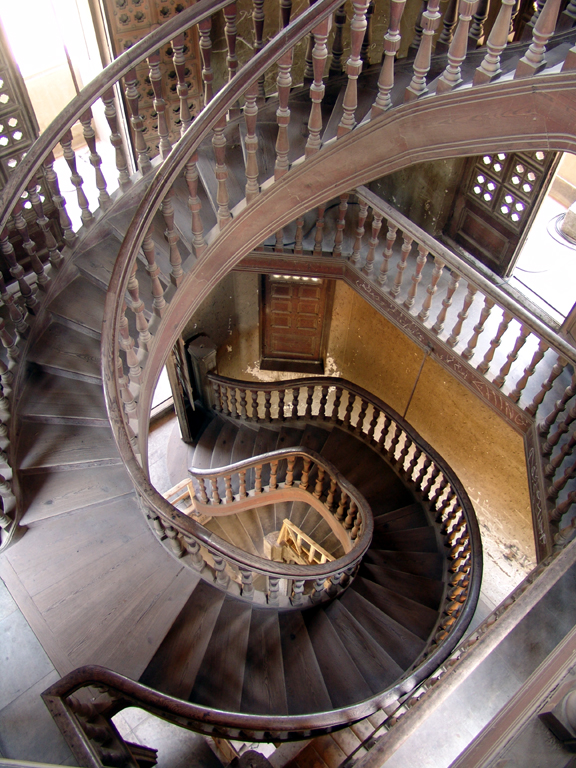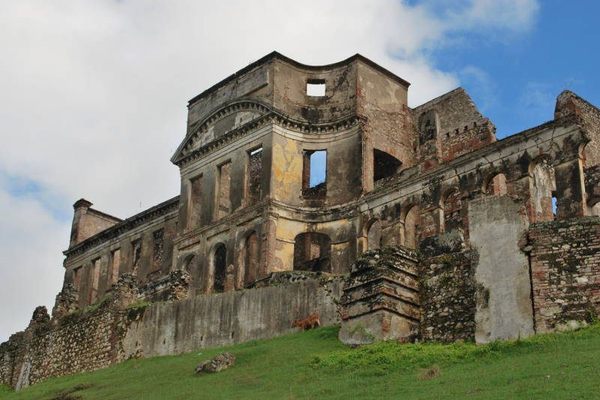Spiraling Out of Control: The Greatest Spiral Stairs in the World
Recently the Loretto Chapel was entered into the Atlas. The Santa Fe chapel is known for a very cool looking set of spiral stairs built in 1877 by a mysterious stranger. With no central support the stairs are said by the sisters of Loretto Chapel to be miraculous in construction. While there are those who beg to differ about the miraculousness of the stairs, no can deny that the stairs look, well, really cool!
The miraculous staircase at Loretto Chapel (photograph by Michael Martin)
In the past I have admitted a somewhat obsessive love of libraries, and looking at the Loretto stairs, made me realize I have a bit of a thing for spiral staircases as well. Like secret passageways and hidden doors there is something intriguing, adventurous even, about a spiral staircase. The narrow twists, and slight dizzy feeling as you ascend, it always seems as if something fantastical awaits you at the top, or alternatively, something dark and ominous at the bottom. Either way, a spiral staircase calls to you saying “find out… if you dare.”
So without further ado, the Atlas Obscura presents to you the most intriguing, fantastical, dizzying spiral staircases from around the world. First the Vatican Museums!
The spiral staircase at the Vatican Museums (photograph by Dimitry B.)
The Vatican Museums spiral staircase is one of the most photographed in the world, and certainty one of the most beautiful. Designed by Giuseppe Momo in 1932, the broad steps are somewhere between a ramp and a staircase.
The Vatican stairs (photograph by Sebastian Bergmann)
As you may be able to see more clearly here, the stairs are actually two separate helixes, one leading up and the other leading down, that twist together in a double helix formation. Little did the Vatican Museum know in 1932 that this formation would come to represent life itself, with the discovery of the double helical DNA strand.
Looking up at the Vatican stairs (photograph by Hailé F)
Many more spiral staircases on the way… just try not to get dizzy.
Another set of very famous spiral stairs are the “Tulip Stairs” in the Queen’s House, in Greenwich, England. These, like the Lorretto Chapel stairs, have no central support, but here they are supported by being cantilevered from the walls, with each step resting on the one below it.
Tulip Stairs at the Queen’s House (via Visit Greenwich)
Built in 1635 and looking distinctly eye-like, these were the first geometric, self-supporting spiral stairs in Britain. Though known as the “Tulip Stairs,” they would be better called the fleurs-de-lis stairs, as that is the symbol repeated (and oft mistaken for a tulip) in the wrought-iron balustrade the runs up the stairs. It is the symbol of the French-born Queen Henrietta Maria’s Bourbon family.
Of course, the stairs have more to them then just their beauty and history. They also have a famous ghost.
In 1966, a Reverend visiting the Queen’s House took this picture, and when he developed it, saw the shrouded image above. Kodak examined the film and said it had not been tampered with, and the Reverend and his wife swore that no one was on the off-limits stairs when they took the picture. It is unclear who the ghost might be, though apparently in the 1600s a maid fell (or jumped) to her death from the stairs, making her a likely candidate to claim the honor.
Baron’s Palace (photograph by Daniel Mayer)
Looking ridiculously like a haunted house from Scooby Doo, is the Baron’s Palace, in Heliopolis, Egypt.
 Baron’s Palace staircase (photograph by Ernie R.)
Baron’s Palace staircase (photograph by Ernie R.)
Within this magnificent house, built for the Belgian industrialist Baron Empain, is a set of beautiful wooden spiral stairs that weave through its center. One of the best myths about the house — along with the usual fare of devil worshipers, ghosts, and secret tunnels — is that the entire structure was built on a rotating base, which allowed the Baron to sit in the center and turn the house to suit his needs. Empain was a fantastic engineer, so I still hold out hope that this is true.
Octagon House in Watertown, WI (photograph by Iulus Ascanius)
This next site is close to my heart, being both a location of fantastic spiral stairs, an octagon house, and located in Wisconsin, near where my grandparents once lived.
Stairs in the Octagon House of Watertown (photograph by David Becker)
Diagram for the spiral staircase of the Octagon House (via Historic American Buildings Survey)
This 1854 octagonal house is made all the more amazing, by its dizzying spiral staircase. Octagon houses have an amazing history and connection to Phrenology, utopian settlers, Victorian health reform, and all sorts of other cool stuff.
Because octagons and spiral stairs go together like white and rice, here is yet another, newer, but still amazing looking spiral staircase in an octagon, this time on Roosevelt Island in New York.
Roosevelt Island Octagon (photograph by Allison Meier/Atlas Obscura)
Another building with a great history, this particular octagon was built in 1841, and was once an insane asylum, before being abandoned, and eventually renovated.
Roosevelt Island is one of those hidden pockets, in the busy city that is still strange, surprising, and filled with bits and pieces of amazing history. While there is more to tell about the island then can be fit here, suffice to say, over the years it served as a prison, quarantine island, gangsters paradise and more. Throughout all this the Octagon remained as did its amazing “flying stairs.”
 via Historic American Buildings Survey
via Historic American Buildings Survey
Today, after a thorough renovation, the building serves as a community center and the stairs, while perhaps a little “new” for my antiquarian tastes, are still really quite amazing looking.
Staircase in the Octagon (photograph by Allison Meier/Atlas Obscura)
Partially because I am lazy, and partially because I want to share many more awesome spiral stairs before boring you to death, from here on out the words will be less, and only one or two pictures per staircase. In other words: Sit back and enjoy the flights!
The Mechanics Institute Library, San Francisco:
Mechanics’ Institute Library (photograph by Mike Behnken)
A triple helix spiral staircase in the Museum do Pobo Galego, Spain (technically, there is no such thing as a spiral staircase — spirals are by their nature flat — and all “spiral” stairs, are actually helical stairs.):
Museum do Pobo Galego, Spain (photograph by Miguel Espinosa)
Contarini del Bovolo, Venice:
Contarini del Bovolo, Venice (photograph by Anna Fox)
The Great Fire Monument, London:
photograph by Matt Brown
photograph by William Pearce
This is an amazing double-helix staircase in the Chateau de Chambord in the Loire Valley of France. The two helixes ascend three floors and never meet. In the center is an open air shaft that lets in light. Some believe Leonardo da Vinci designed the staircase, but this is as of yet, unconfirmed:

photograph by Hélène Rival/Wikimedia
Quinta de Regaleira, Sintra, Portugal (written about on the Atlas here):
photograph by Iker Larrañaga
The chimney of the old Bóbila Almirall in Terrassa, Spain. The world’s tallest chimney with a spiral staircase:
photograph by CavallBerenat/Wikimedia
Palazzo Barberini, Rome, Italy:
photograph by sailko/Wikimedia
Spiral Stairs carved out of a Kauri Tree at the Ancient Kauri Museum, New Zealand:
photograph by Mr. Tickle/Wikimedia
A scary looking staircase in the Moaning Cavern stairway, California:
photograph by Don Richards
Awesome looking spiral staircase at the abandoned Western State Hospital, Washington:
photograph by Lindsay Blair Brown
And finally to end it, with one of the oldest forms of spiral stairs, the Ziggurat, in this case the Great Mosque of Samarra:
photograph by Jennifer Morrow
Hope you enjoyed this very incomplete collection of some of the worlds greatest spiral staircases, and if you are anything like me, you are dizzy and need to go lie down for a second.
Want to scale even more strange staircases? Going exploring on the Atlas Obscura >



















Follow us on Twitter to get the latest on the world's hidden wonders.
Like us on Facebook to get the latest on the world's hidden wonders.
Follow us on Twitter Like us on Facebook